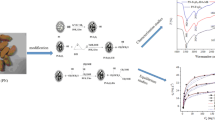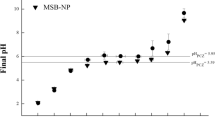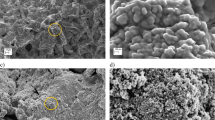Abstract
Industrial dyes are harmful compounds often present in wastewater. In this work, a magnetic nanohybrid material (HB) was hydrothermally synthesized from pyrolyzed sugarcane straw (CN) and magnetic iron oxide nanoparticles. The material was characterized by XRD, FTIR, SEM, TGA, and PZC, and tested for the adsorptive removal of congo red (CR) and indigo carmine (IC) dyes from aqueous solutions at pH 7.0 and 10.0, respectively. The kinetics of adsorption was well explained by both the pseudo-second order (PSO) model (\(R_{adj}^{2} \sim 0.99\) for CR, 0.96 for IC) and the Elovich model (\(R_{adj}^{2}\) ~ 0.98 for CR, 0.98 for IC). After 24 h, the maximum adsorption capacities of the material were ~ 18.39 mg g−1 for CR and ~ 1.46 mg g−1 for IC. Adsorption isotherms were obtained at 25, 35, and 45 °C, and four different models were tested. The Sips model, which combines Langmuir and Freundlich, was used to fit the data. HB exhibited greater performance removing CR dye (%R ~ 72%) than IC (%R ~ 27%), therefore suggesting great potential as an adsorbent for CR from wastewater.












Similar content being viewed by others
References
Abualnaja KM, Alprol AE, Abu-Saied MA et al (2021) Studying the adsorptive behavior of poly(Acrylonitrile-co-styrene) and carbon nanotubes (nanocomposites) impregnated with adsorbent materials towards methyl orange dye. Nanomaterials 11:1144. https://doi.org/10.3390/nano11051144
Achieng’ GO, Kowenje CO, Lalah JO, Ojwach SO (2021) Synthesis and characterization of FSB@Fe3O4 composites and application in removal of indigo carmine dye from industrial wastewaters. Environ Sci Pollut Res 28:54876–54890. https://doi.org/10.1007/s11356-021-14432-1
Ahmad S, Wong YC, Veloo KV (2018) Sugarcane bagasse powder as biosorbent for reactive red 120 removals from aqueous solution. IOP Conf Ser Earth Environ Sci 140:012027. https://doi.org/10.1088/1755-1315/140/1/012027
Ajenifuja E, Ajao JA, Ajayi EOB (2017) Equilibrium adsorption isotherm studies of Cu(II) and Co(II) in high concentration aqueous solutions on Ag-TiO2-modified kaolinite ceramic adsorbents. Appl Water Sci 7:2279–2286. https://doi.org/10.1007/s13201-016-0403-6
Al-Ghouti MA, Al-Absi RS (2020) Mechanistic understanding of the adsorption and thermodynamic aspects of cationic methylene blue dye onto cellulosic olive stones biomass from wastewater. Sci Rep 10:1–18. https://doi.org/10.1038/s41598-020-72996-3
Aoopngan C, Nonkumwong J, Phumying S et al (2019) Amine-functionalized and hydroxyl-functionalized magnesium ferrite nanoparticles for congo red adsorption. ACS Appl Nano Mater 2:5329–5341. https://doi.org/10.1021/acsanm.9b01305
Arenas CN, Vasco A, Betancur M, Martínez JD (2017) Removal of indigo carmine (IC) from aqueous solution by adsorption through abrasive spherical materials made of rice husk ash (RHA). Process Saf Environ Prot 106:224–238. https://doi.org/10.1016/j.psep.2017.01.013
Batra VS, Urbonaite S, Svensson G (2008) Characterization of unburned carbon in bagasse fly ash. Fuel 87:2972–2976. https://doi.org/10.1016/j.fuel.2008.04.010
Bedia J, Peñas-Garzón M, Gómez-Avilés A et al (2018) A review on the synthesis and characterization of biomass-derived carbons for adsorption of emerging contaminants from water. C 4:63. https://doi.org/10.3390/c4040063
Belachew N, Bekele G (2020) Synergy of magnetite intercalated bentonite for enhanced adsorption of congo red dye. SILICON 12:603–612. https://doi.org/10.1007/s12633-019-00152-2
Bhowmik S, Chakraborty V, Das P (2021) Batch adsorption of indigo carmine on activated carbon prepared from sawdust: a comparative study and optimization of operating conditions using Response Surface Methodology. Results Surf Interfaces 3:100011. https://doi.org/10.1016/j.rsurfi.2021.100011
Cornell RM, Schwertmann U (2003) The iron oxides: structure, properties, reactions, occurrences and uses. Wiley
Cullity BD, Stock SR (2014) Elements of X-ray diffraction, 2nd edn. Michigan
Damasceno BS, Da Silva AFV, De Araújo ACV (2020) Dye adsorption onto magnetic and superparamagnetic Fe3O4 nanoparticles: a detailed comparative study. J Environ Chem Eng 8:103994. https://doi.org/10.1016/j.jece.2020.103994
De Araújo ACV (2011) Síntese de nanopartículas de Fe3O4, nanocompósitos de Fe3O4 com polímeros e materiais carbonáceos. Universidade Federal de Pernambuco, Thesis
De Gisi S, Lofrano G, Grassi M, Notarnicola M (2016) Characteristics and adsorption capacities of low-cost sorbents for wastewater treatment: a review. Sustain Mater Technol 9:10–40. https://doi.org/10.1016/j.susmat.2016.06.002
dos Santos Rocha MSR, Pratto B, de Sousa R et al (2017a) A kinetic model for hydrothermal pretreatment of sugarcane straw. Bioresour Technol 228:176–185. https://doi.org/10.1016/j.biortech.2016.12.087
dos Santos RMM, Gonçalves RGL, Constantino VRL et al (2017b) Adsorption of acid yellow 42 dye on calcined layered double hydroxide: effect of time, concentration, pH and temperature. Appl Clay Sci 140:132–139. https://doi.org/10.1016/j.clay.2017.02.005
French AD (2014) Idealized powder diffraction patterns for cellulose polymorphs. Cellulose 21:885–896. https://doi.org/10.1007/s10570-013-0030-4
Godoy-Jr A, Pereira A, Gomes M et al (2020) Black TiO2 thin films production using hollow cathode hydrogen plasma treatment: synthesis, material characteristics and photocatalytic activity. Catalysts 5:1–8. https://doi.org/10.3390/catal10030282
Gupta TB, Lataye DH (2017) Adsorption of indigo carmine dye onto acacia nilotica (babool) sawdust activated carbon. J Hazard Toxic Radioact Waste 21:04017013. https://doi.org/10.1061/(asce)hz.2153-5515.0000365
Hall KR, Eagleton LC, Acrivos A, Vermeulen T (1966) Pore- and solid-diffusion kinetics in fixed-bed adsorption under constant-pattern conditions. Ind Eng Chem Fundam 5:212–223. https://doi.org/10.1021/i160018a011
Hasanpour M, Hatami M (2020) Photocatalytic performance of aerogels for organic dyes removal from wastewaters: review study. J Mol Liq 309:113094. https://doi.org/10.1016/j.molliq.2020.113094
Hasanpour M, Motahari S, Jing D, Hatami M (2021a) Investigation of operation parameters on the removal efficiency of methyl orange pollutant by cellulose/zinc oxide hybrid aerogel. Chemosphere 284:131320. https://doi.org/10.1016/j.chemosphere.2021.131320
Hasanpour M, Motahari S, Jing D, Hatami M (2021b) Investigation of the different morphologies of zinc oxide (ZnO) in cellulose/ZnO hybrid aerogel on the photocatalytic degradation efficiency of methyl orange. Top Catal. https://doi.org/10.1007/s11244-021-01476-3
Hu Q, Liu Y, Feng C et al (2018) Predicting equilibrium time by adsorption kinetic equations and modifying Langmuir isotherm by fractal-like approach. J Mol Liq 268:728–733. https://doi.org/10.1016/j.molliq.2018.07.113
Jawaid M, Kian LK, Fouad H et al (2021) Morphological, structural, and thermal analysis of three part of Conocarpus cellulosic fibres. J Mater Res Technol 10:24–33. https://doi.org/10.1016/j.jmrt.2020.11.108
Kosmulski M (2011) The pH-dependent surface charging and points of zero charge. V. Update. J Colloid Interface Sci 353:1–15. https://doi.org/10.1016/j.jcis.2010.08.023
Kosmulski M (2016) Isoelectric points and points of zero charge of metal (hydr)oxides: 50 years after Parks’ review. Adv Colloid Interface Sci 238:1–61. https://doi.org/10.1016/j.cis.2016.10.005
Langmuir I (1919) The adsorption of gases on plane surfaces of glass, mica and platinum. J Am Chem Soc 40:1361–1403. https://doi.org/10.1021/ja02242a004
Li S, Zhang S, Wang X (2008) Fabrication of superhydrophobic cellulose-based materials through a solution-immersion process. Langmuir 24:5585–5590. https://doi.org/10.1021/la800157t
Liao Z, Huang Z, Hu H et al (2011) Microscopic structure and properties changes of cassava stillage residue pretreated by mechanical activation. Bioresour Technol 102:7953–7958. https://doi.org/10.1016/j.biortech.2011.05.067
Libra JA, Ro KS, Kammann C et al (2011) Hydrothermal carbonization of biomass residuals: a comparative review of the chemistry, processes and applications of wet and dry pyrolysis. Biofuels 2:71–106. https://doi.org/10.4155/bfs.10.81
Lopičić ZR, Stojanović MD, Marković SB et al (2019) Effects of different mechanical treatments on structural changes of lignocellulosic waste biomass and subsequent Cu(II) removal kinetics. Arab J Chem 12:4091–4103. https://doi.org/10.1016/j.arabjc.2016.04.005
Machado G, Santos F, Faria D et al (2018) Characterization and potential evaluation of residues from the sugarcane industry of Rio Grande do Sul in biorefinery processes. Nat Resour 09:175–187. https://doi.org/10.4236/nr.2018.95011
Marković S, Stanković A, Lopičić Z et al (2015) Application of raw peach shell particles for removal of methylene blue. J Environ Chem Eng 3:716–724. https://doi.org/10.1016/j.jece.2015.04.002
McKay G, Blair HS, Gardner JR (1982) Adsorption of Dyes on Chitin. J Appl Polym Sci 27:3043–3057. https://doi.org/10.1007/978-981-10-6293-3_2
Mera SL, Davies JD (1984) Differential congo red staining: the effects of pH, non-aqueous solvents and the substrate. Histochem J 16:195–210. https://doi.org/10.1007/BF01003549
Nordin AH, Wong S, Ngadi N et al (2021) Surface functionalization of cellulose with polyethyleneimine and magnetic nanoparticles for efficient removal of anionic dye in wastewater. J Environ Chem Eng 9:104639. https://doi.org/10.1016/j.jece.2020.104639
Park JH, Wang JJ, Meng Y et al (2019) Adsorption/desorption behavior of cationic and anionic dyes by biochars prepared at normal and high pyrolysis temperatures. Colloids Surf A Physicochem Eng Asp 572:274–282. https://doi.org/10.1016/j.colsurfa.2019.04.029
Phat LN, Nguyen HC, Khoa BDD et al (2022) Synthesis and surface modification of cellulose cryogels from coconut peat for oil adsorption. Cellulose 29:2435–2447. https://doi.org/10.1007/s10570-022-04427-7
Poolwong J, Kiatboonyarit T, Achiwawanich S et al (2021) Three-dimensional hierarchical porous TiO2 for enhanced adsorption and photocatalytic degradation of remazol dye. Nanomaterials 11:1715. https://doi.org/10.3390/nano11071715
Proctor A, Toro-Vazquez JF (1996) The Freundlich isotherm in studying adsorption in oil processing. J Am Oil Chem Soc 73:1627–1633. https://doi.org/10.1007/BF02517963
Rodríguez-Díaz JM, García JOP, Sánchez LRB et al (2015) Comprehensive characterization of sugarcane bagasse ash for its use as an adsorbent. Bioenergy Res 8:1885–1895. https://doi.org/10.1007/s12155-015-9646-6
Scheufele FB, Ribeiro C, Módenes AN et al (2015) Assessment of drying temperature of sugarcane bagasse on sorption of reactive blue 5G dye. Fibers Polym 16:1646–1656. https://doi.org/10.1007/s12221-015-5087-2
Shao X, Wang J, Liu Z et al (2021) Cellulose based cation-exchange fiber as filtration material for the rapid removal of methylene blue from wastewater. Cellulose 28:9355–9367. https://doi.org/10.1007/s10570-021-04103-2
Shrestha D (2021) Efficiency of wood-dust of dalbergia sisoo as low-cost adsorbent for rhodamine-B dye removal. Nanomater 11:2217. https://doi.org/10.3390/nano11092217
Siddiqui SI, Rathi G, Chaudhry SA (2018) Acid washed black cumin seed powder preparation for adsorption of methylene blue dye from aqueous solution: thermodynamic, kinetic and isotherm studies. J Mol Liq 264:275–284. https://doi.org/10.1016/j.molliq.2018.05.065
Srinivasan A, Viraraghavan T (2010) Decolorization of dye wastewaters by biosorbents: a review. J Environ Manag 91:1915–1929. https://doi.org/10.1016/j.jenvman.2010.05.003
Taher T, Putra R, Rahayu Palapa N, Lesbani A (2021) Preparation of magnetite-nanoparticle-decorated NiFe layered double hydroxide and its adsorption performance for congo red dye removal. Chem Phys Lett 777:138712. https://doi.org/10.1016/j.cplett.2021.138712
Wahab R, Khan F, Kaushik NK et al (2017) Photocatalytic TMO-NMs adsorbent: temperature-time dependent Safranine degradation, sorption study validated under optimized effective equilibrium models parameter with standardized statistical analysis. Sci Rep 7:1–15. https://doi.org/10.1038/srep42509
Wang J, Guo X (2020) Adsorption kinetic models: physical meanings, applications, and solving methods. J Hazard Mater 390:122156. https://doi.org/10.1016/j.jhazmat.2020.122156
Yağmur HK, Kaya İ (2021) Synthesis and characterization of magnetic ZnCl2-activated carbon produced from coconut shell for the adsorption of methylene blue. J Mol Struct 1232:130071. https://doi.org/10.1016/j.molstruc.2021.130071
Zanoni TB, Cardoso AA, Zanoni MVB, Ferreira AAP (2010) Exploratory study on sequestration of some essential metals by indigo carmine food dye. Braz J Pharm Sci 46:723–730. https://doi.org/10.1590/S1984-82502010000400014
Acknowledgments
We gratefully acknowledge the financial support from Brazilian agencies Fundação de Amparo a Ciência e Tecnologia do Estado de Pernambuco (APQ 0692-1.06/15), Conselho Nacional de Desenvolvimento Científico e Tecnológico, and Coordenação de Aperfeiçoamento de Pessoal de Nível Superior. We thank Laboratório de Plasmas e Processos, from Instituto Tecnológico de Aeronáutica, Brazil, for providing the analysis on the thermogravimetric analyzer and X-ray diffractometer equipment.
Funding
This work was supported by Brazilian agencies Fundação de Amparo a Ciência e Tecnologia do Estado de Pernambuco (FACEPE, Grant Number APQ 0692-1.06/15), Conselho Nacional de Desenvolvimento Científico e Tecnológico (CNPq), and Coordenação de Aperfeiçoamento de Pessoal de Nível Superior (CAPES).
Author information
Authors and Affiliations
Contributions
All authors contributed to the study conception and design, as well as data analysis. Material preparation and data collection were performed by R.K.doN., B.S.D., A.N.deM, P.H.M.deF., J.V.F.L.C., and A.C.V.dA. The first draft of the manuscript was written by R.K.doN., B.S.D., E.H.L.F., and A.C.V.deA., and all authors commented on previous versions of the manuscript. All authors read and approved the final manuscript.
Corresponding author
Ethics declarations
Conflict of interest
The authors have no competing interests to declare that are relevant to the content of this article.
Additional information
Publisher's Note
Springer Nature remains neutral with regard to jurisdictional claims in published maps and institutional affiliations.
Supplementary Information
Below is the link to the electronic supplementary material.
Rights and permissions
Springer Nature or its licensor (e.g. a society or other partner) holds exclusive rights to this article under a publishing agreement with the author(s) or other rightsholder(s); author self-archiving of the accepted manuscript version of this article is solely governed by the terms of such publishing agreement and applicable law.
About this article
Cite this article
do Nascimento, R.K., Damasceno, B.S., de Melo, A.N. et al. Hybrid nanomaterial from pyrolyzed biomass and Fe3O4 magnetic nanoparticles for the adsorption of textile dyes. Cellulose 30, 2483–2501 (2023). https://doi.org/10.1007/s10570-022-04978-9
Received:
Accepted:
Published:
Issue Date:
DOI: https://doi.org/10.1007/s10570-022-04978-9




